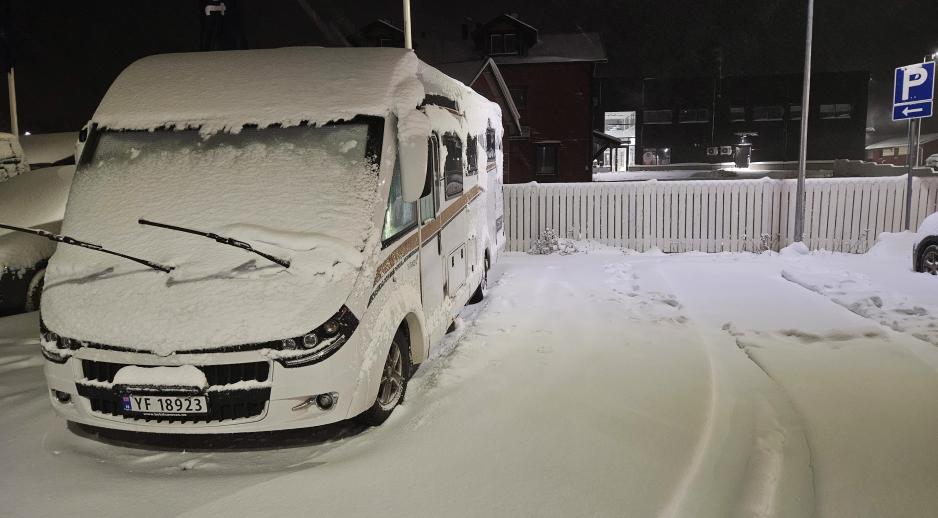Arne O. Holm says I Am on the Border Between Norway and Russia – Searching for Hope

The last rays of sunshine before the north enters the Polar Night. (Photo: Arne O. Holm)
Comment (Skogfoss, Eastern Finnmark): This winter, I have once again traveled through border areas in international media's absolute margins. I am currently on the literal border with Russia. One step further would be one step too far. The border is here.
While Vladimir Putin is sending a continuous stream of deadly weapons into Ukraine, I am in Skogfoss, east in Finnmark, Northern Norway, to celebrate a Norwegian power plant built into the bottom of a river that marks the border between Norway and Russia.
It runs in the middle of the dam that regulates 25 percent of the power consumption in Finnmark.
Split down the middle
Half of the dam and all the gates are on the Russian side. Skogfoss power plant and the rest of the dam are in Norway. The power plant turbines were first started in 1964 – 60 years ago.
Yet, this unique, by today's standards, energy cooperation stretches even further back in time. In 1955, when Einar Gerhardsen was the Norwegian prime minister, he accepted an invitation to Moscow.
Ten years after the war, Germany was a member of NATO.
The communist coup in Czechoslovakia had left deep scars on the Nordic social democrats. NATO was established in 1949, and the Warsaw Pact was established in the same year Gerhardsen traveled to Moscow.
There were riots in East Berlin, and the year after Gerhardsen's state visit included the revolution in Hungary, riots in Poland, and the Suez Crisis, which had already started before Gerhardsen left.
Arms race
There was anything but détente, and there were few if any, signs that an out-of-control arms race was about to stop. Instead, the fear of a nuclear war was real and growing.
Einar Gerhardsen went to Moscow with proposals for a trade agreement, demands for releasing Norwegian prisoners in the Soviet Union, and proposals for establishing cultural relations.
Less attention was drawn to the fact that he also proposed a Norwegian-Soviet collaboration on developing the Pasvik River—an energy collaboration to rebuild the burned-out Finnmark.

A few weeks ago, I was stuck in what felt like a blizzard on Lake Inari's shores in Finland. (Photo: Arne O. Holm)
It was not at all obvious.
"Prosaic," said the powerful Labor Secretary General, Håkon Lie, about the proposal.
Yet, a few years later, the agreement was formalized, and in 1964, the power produced in the Skogfoss power plant was used for industry and light in the eastern Finnmark houses.
A few weeks ago, I was stuck in what was reminiscent of a blizzard on the Finnish Lake Inari shores. It fills Norwegian and Russian power turbines with water. It is a quite unique three-country cooperation between Finland, Russia, and Norway that still exists today.
No physical meetings
Sanctions have halted the physical meetings, but the digital contact between the three countries enables cooperation, even when most other channels between East and West are closed.
During the coldest Cold War.
It is too early to identify how it will be possible to create peace in Europe, but history tells us something about how unpredictable the future is.
Six years after NATO's establishment, ten years after German nazis had set Europe ablaze, Germany was a member of the western defense alliance. Only ten years ago, the then Norwegian MFA Børge Brende met his Russian colleague Sergey Lavrov in Kirkenes.
In ten years, Putin will be 82, and Donald Trump will be 88. Norway's King Harald was joking and laughing with the same Russian MFA five years ago. That also took place in Kirkenes, Norway's border city against Russia.
I don't know what will happen in the next few years. But I know that when the east and west gates have been closed and locked, some have continued their cooperation.
Putin will be 82 years old, Trump will be 88.
Congratulations Skogfoss
In Svalbard, between the Governor in Longyearbyen and the Russian regime in Barentsburg.
In the sea outside Northern Norway, the powerful Barents Sea, a joint Norwegian-Russian fisheries commission.
In Pasvik in Sør-Varanger municipality, a civil, border-crossing cooperation on essential energy.
In these non-military and civil constructions, all in the north, at least there is hope.
There is every reason to congratulate Pasvik Kraft, owned by Varanger Kraft, on the 60th anniversary of the Skogfoss power plant.



